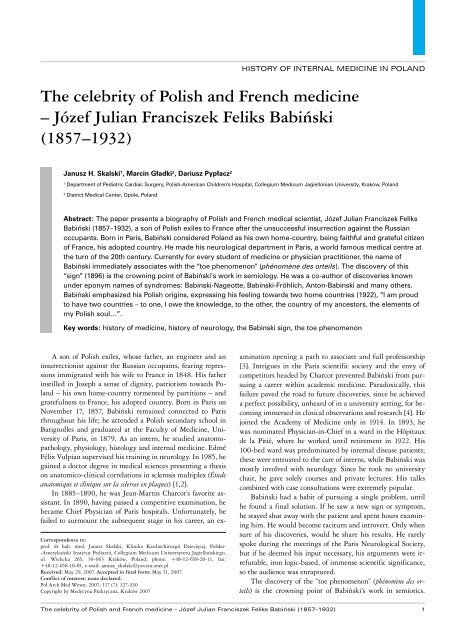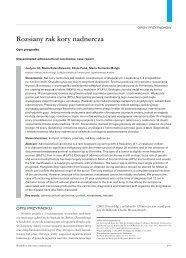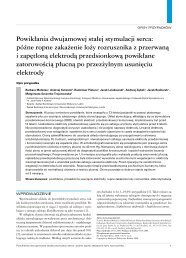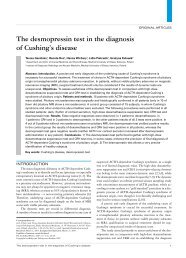Pdf version - polskie archiwum medycyny wewnętrznej
Pdf version - polskie archiwum medycyny wewnętrznej
Pdf version - polskie archiwum medycyny wewnętrznej
Create successful ePaper yourself
Turn your PDF publications into a flip-book with our unique Google optimized e-Paper software.
HISTORY OF INTERNAL MEDICINE IN POLAND<br />
The celebrity of Polish and French medicine<br />
– Józef Julian Franciszek Feliks Babiński<br />
(1857–1932)<br />
Janusz H. Skalski 1 , Marcin Gładki 2 , Dariusz Pypłacz 2<br />
1<br />
Department of Pediatric Cardiac Surgery, Polish-American Children’s Hospital, Collegium Medicum Jagiellonian University, Kraków, Poland<br />
2<br />
District Medical Center, Opole, Poland<br />
Abstract: The paper presents a biography of Polish and French medical scientist, Józef Julian Franciszek Feliks<br />
Babiński (1857–1932), a son of Polish exiles to France after the unsuccessful insurrection against the Russian<br />
occupants. Born in Paris, Babiński considered Poland as his own home-country, being faithful and grateful citizen<br />
of France, his adopted country. He made his neurological department in Paris, a world famous medical centre at<br />
the turn of the 20th century. Currently for every student of medicine or physician practitioner, the name of<br />
Babiński immediately associates with the “toe phenomenon” (phénomène des orteils). The discovery of this<br />
“sign” (1896) is the crowning point of Babiński’s work in semiology. He was a co-author of discoveries known<br />
under eponym names of syndromes: Babinski-Nageotte, Babinski-Fröhlich, Anton-Babinski and many others.<br />
Babiński emphasized his Polish origins, expressing his feeling towards two home countries (1922), “I am proud<br />
to have two countries – to one, I owe the knowledge, to the other, the country of my ancestors, the elements of<br />
my Polish soul…”.<br />
Key words: history of medicine, history of neurology, the Babinski sign, the toe phenomenon<br />
A son of Polish exiles, whose father, an engineer and an<br />
insurrectionist against the Russian occupants, fearing repressions<br />
immigrated with his wife to France in 1848. His father<br />
instilled in Joseph a sense of dignity, patriotism towards Poland<br />
– his own home-country tormented by partitions – and<br />
gratefulness to France, his adopted country. Born in Paris on<br />
November 17, 1857, Babiński remained connected to Paris<br />
throughout his life; he attended a Polish secondary school in<br />
Batignolles and graduated at the Faculty of Medicine, University<br />
of Paris, in 1879. As an intern, he studied anatomopathology,<br />
physiology, histology and internal medicine. Edmé<br />
Félix Vulpian supervised his training in neurology. In 1985, he<br />
gained a doctor degree in medical sciences presenting a thesis<br />
on anatomico-clinical correlations in sclerosis multiplex (Étude<br />
anatomique et clinique sur la sclerose en plaques) [1,2].<br />
In 1885–1890, he was Jean-Martin Charcot’s favorite assistant.<br />
In 1890, having passed a competitive examination, he<br />
became Chief Physician of Paris hospitals. Unfortunately, he<br />
failed to surmount the subsequent stage in his career, an ex-<br />
Correspondence to:<br />
prof. dr hab. med. Janusz Skalski, Klinika Kardiochirurgii Dziecięcej, Polsko-<br />
-Amerykański Instytut Pediatrii, Collegium Medicum Uniwersytetu Jagiellońskiego,<br />
ul. Wielicka 265, 30-663 Kraków, Poland, phone: +48-12-658-20-11, fax:<br />
+48-12-658-10-81, e-mail: janusz_skalski@poczta.onet.pl<br />
Received: May 29, 2007. Accepted in final form: May 31, 2007.<br />
Conflict of interest: none declared.<br />
Pol Arch Med Wewn. 2007; 117 (7): 327-330<br />
Copyright by Medycyna Praktyczna, Kraków 2007<br />
amination opening a path to associate and full professorship<br />
[3]. Intrigues in the Paris scientific society and the envy of<br />
competitors headed by Charcot prevented Babiński from pursuing<br />
a career within academic medicine. Paradoxically, this<br />
failure paved the road to future discoveries, since he achieved<br />
a perfect possibility, unheard of in a university setting, for becoming<br />
immersed in clinical observations and research [4]. He<br />
joined the Academy of Medicine only in 1914. In 1893, he<br />
was nominated Physician-in-Chief in a ward in the Hôpitaux<br />
de la Pitié, where he worked until retirement in 1922. His<br />
100-bed ward was predominated by internal disease patients;<br />
these were entrusted to the care of interns, while Babiński was<br />
mostly involved with neurology. Since he took no university<br />
chair, he gave solely courses and private lectures. His talks<br />
combined with case consultations were extremely popular.<br />
Babiński had a habit of pursuing a single problem, until<br />
he found a final solution. If he saw a new sign or symptom,<br />
he stayed shut away with the patient and spent hours examining<br />
him. He would become taciturn and introvert. Only when<br />
sure of his discoveries, would he share his results. He rarely<br />
spoke during the meetings of the Paris Neurological Society,<br />
but if he deemed his input necessary, his arguments were irrefutable,<br />
iron logic-based, of immense scientific significance,<br />
so the audience was enraptured.<br />
The discovery of the “toe phenomenon” (phénomène des orteils)<br />
is the crowning point of Babiński’s work in semiotics.<br />
The celebrity of Polish and French medicine – Józef Julian Franciszek Feliks Babiński (1857–1932) 1
HISTORY OF INTERNAL MEDICINE IN POLAND<br />
Fig. 2. Babiński in his sixties. By courtesy of the Chair of History of<br />
Medicine, Collegium Medicum, Jagiellonian University<br />
Fig. 1. Babiński in his forties. By courtesy of the Chair of History of<br />
Medicine, Collegium Medicum, Jagiellonian University<br />
February 22, 1896, when the Paris Biological Society received<br />
the communication On the plantar reflex in some organic diseases<br />
of the nervous system became a historical date in neurology [5,6].<br />
Typically of Babiński, ever economical with words; the report<br />
was only 28 lines long.<br />
He supplemented the semiology of the reflex in 1903, describing<br />
toe abduction (the fan sign, signe d’éventail) [7,8]. He<br />
regarded it very important, stressing that in pyramidal tract<br />
damage, apart from great toe extension, the patient manifests<br />
also flexion and abduction of the other toes.<br />
A superb clinician, Babiński understood that knowing<br />
neurological signs in normal and pathological situations is fundamentally<br />
important in neurology. His early papers focused<br />
on reflexes and establishing which were physiologically fixed<br />
and which developed in pathological states. He demonstrated<br />
that deep reflexes are fixed, but their hyperactivity, hypoactivity,<br />
absence or asymmetry indicate a pathology, and proved<br />
that conjunctival, corneal and gag reflexes may be absent in<br />
healthy subjects, but their asymmetry indicates an organic disease<br />
background. His famous lecture On tendon and periosteal<br />
reflexes precisely defined the role of reflexivity studies [9,10].<br />
Babiński developed the semiology of organic hemiplegia<br />
and transverse spinal cord lesions, described the majority of<br />
pyramidal signs and demonstrated increased tendon and periosteal<br />
reflexes accompanied by the so-called clonus verus and<br />
toe sign as constant signs appearing in late-stage hemiplegias.<br />
He distinguished two types of transverse spinal cord paralysis:<br />
with tendon contraction or excessive tendon stretching; demonstrating<br />
defense reflexes in pyramidal tract damage and<br />
their independence of intensified tendon reflexes. Babiński’s<br />
knowledge of defense reflexes allowed for determination of the<br />
spinal cord tumor margin.<br />
Recognizing the diagnostic value of clinical characteristics<br />
of nervous system-affecting syphilis is among Babiński’s major<br />
successes. In 1899, he was the first to claim that an absent<br />
pupil reaction to light was pathognomic; together with Augustin<br />
Charpentier (1901), he showed the importance of the<br />
Argyll-Robertson pupil sign, equaling it in significance with<br />
the Hutchinson’s triad or Fournier’s pleiade [11].<br />
In 1900, one year before Alfred Fröhlich [12], Babiński described<br />
adiposogenital dystrophy in pituitary tumors. Today,<br />
this syndrome is named after Babiński and Fröhlich.<br />
Babiński concentrated on cerebellar symptomatology in<br />
1899–1913; providing the foundation for diagnostic management<br />
of cerebellar diseases. The chief paper of that period<br />
seems to be a lecture On cerebellar signs and their diagnostic importance,<br />
presented at the International Medical Congress in<br />
London and published by Babiński and his student, August<br />
POLSKIE ARCHIWUM MEDYCYNY WEWNĘTRZNEJ 2007; 117 (7)
HISTORY OF INTERNAL MEDICINE IN POLAND<br />
Fig. 3. Babinski Memorial Hospital in Kobierzyn (near Krakow). Two recently renovated buildings of 18 hospital facilities originating from<br />
1918. By courtesy of the Management of Hospital<br />
Tournay, in Neurologia Polska in 1914. Here Babiński described<br />
the signs he observed – hypermetria, asynergia, adiadochokinesis,<br />
intention tremor and catalepsy – later regarded as classic.<br />
Labyrinth testing by means of galvanic current introduced<br />
by Babiński (1901) allowed for diagnosing unilateral damage<br />
(mostly unilateral hearing defects). He described clinical features<br />
helpful in differentiating between cerebellar vs. peripheral<br />
and spinal ataxia. He believed a disturbed regulation in<br />
agonist and synergist innervation was a pathomechanism underlying<br />
cerebellar disturbances [1,11].<br />
Together with Jean Nageotte, Babiński distinguished<br />
a syndrome characteristic of vascular foci in the medulla oblongata<br />
(1902), presenting his observations in 1905–1906.<br />
This syndrome named after Babiński and Nageotte, today is<br />
recognized as a variant of lateral medullary syndrome; it develops<br />
when the posterior inferior cerebellar artery is occluded<br />
[13].<br />
Babiński contributed to the discovery of a syndrome where<br />
a blind person negates his blindness (the Anton-Babiński syndrome;<br />
denial visual hallucination syndrome). Gabriel Anton<br />
described the phenomenon in 1899; Babiński introduced the<br />
term „anosognosia” (1914) in hemiplegic patients, who, unaware<br />
of their condition, demonstrated somatognosia and anosodiaphoria<br />
[11].<br />
Babiński studied the nature of hysteria, which he regarded<br />
an effect of suggestive influence, termed “pitiatism” and<br />
believed treatable by persuasion. He also investigated the socalled<br />
physiopathological disturbances of a reflexive nature,<br />
usually trauma-evoked, publishing these observations together<br />
with Jules Froment (1917) in their book Hystérie-Pithiatisme<br />
et troubles nerveux d’ordre rérflexe [14].<br />
Babiński was the first in France and among the first worldwide<br />
to understand and advocate surgical treatment of brain<br />
and spinal tumors, thus contributing to neurosurgery development.<br />
A break-through was a successful removal of a spinal tumor,<br />
preceded by a precise establishment of its localization by<br />
Babiński (1911) [15]. He introduced X-ray irradiation in spinal<br />
compression (1906), developed the symptomatology of organic<br />
hemiplegia and transverse spinal cord lesions, cerebellar diseases,<br />
etc. He authored 288 papers. The University of Warsaw<br />
offered him the Chair of Neurology when it was established in<br />
1925, but Babiński, a retiree, declined. He was elected honorary<br />
professor of the Vilnius University and honorary member<br />
of numerous scientific societies, including three in Poland.<br />
In 1899, he co-founded the French Société de Neurologie. In<br />
1907, he became its president. Having retired – a great shock<br />
in itself – he continued consulting patients until 1931, when<br />
his brother Henry, a culinary master, died. Joseph was very<br />
close to Henry and they lived together for a long time. Henry’s<br />
demise brought a breakdown. As his father’s before, Babiński’s<br />
last years were plagued by parkinsonism [1]. He died on October<br />
29, 1932.<br />
Babiński repeatedly emphasized his Polish origins. At the<br />
meeting with professors and physicians in Vilnius in 1922, he<br />
toasted his two home countries: “I am proud to have two countries<br />
– to one, I owe the knowledge, to the other, the country<br />
of my ancestors, the elements of my Polish soul. These two<br />
feelings have combined in me forming a unity...”.<br />
In his eulogy, Tournay thus spoke about this phenomenal<br />
scientist: “Il était beau, Il fut bon, Il restait vrai” [11] (He was<br />
beautiful. He was good. He remained true.).<br />
REFERENCES<br />
1. van Gijn J. The Babinski sign – a century. Utrecht, Universiteit Utrecht, 1996: 17-38.<br />
2. Babinski J. Étude anatomique et clinique sur la sclérose en plaques. Paris,<br />
G Masson, 1885.<br />
3. Vaquez H. Joseph Babinski (1857–1932). Bulletin de l’Académie de Médecine.<br />
1932; 108: 1264-1273.<br />
4. Iragui VJ. The Charcot-Bouchard controversy. Arch Neurol. 1986; 43: 290-295.<br />
5. Babinski J. Sur le réflexe cutané plantaire dans certaines affections du système<br />
nerveux central. Comptes rendus des Séances et Mémoires de la Société de<br />
Biologie. 1896: 207-208.<br />
6. Babinski J. Du phénomène des orteils et de sa valeur semiologique. Semaine<br />
Médicale. 1898; 18: 321-322.<br />
The celebrity of Polish and French medicine – Józef Julian Franciszek Feliks Babiński (1857–1932) 3
HISTORY OF INTERNAL MEDICINE IN POLAND<br />
7. Babinski J. De l’abduction des orteils. Revue Neurologique. 1903; 11: 728-729.<br />
8. Babinski J. De l’abduction des orteils (signe de d’éventail). Revue Neurologique.<br />
1903; 11: 1205-1206.<br />
9. Cohn R. The Babinski sign extinction during bilateral simultaneous cutaneous stimulation.<br />
J Neurophysiol. 1948; 11: 193-197.<br />
10. Nathan PW. Effects on movement of surgical incisions into the human spinal cord.<br />
Brain. 1994; 117: 337-346.<br />
11. Herman EJ. Historia neurologii <strong>polskie</strong>j. Wrocław, Zakład Ossolińskich, 1975; 97:<br />
147-155.<br />
12. Babinski JF. Tumeur du corps pituitaire sans acromégalie et avec arrêt de développement<br />
des organes génitaux. Revue Neurologique. 1900; 8: 531-535.<br />
13. Babinski JJFF, Nageotte J. Hémiasynergie, latéropulsion et myosis bulbaires avec<br />
hémianesthésie et hémiplégie croisées. Nouvelle iconographie de la Salpêtrière.<br />
Paris, G Masson, 1902.<br />
14. Babinski JF, Froment J. Hystérie-pithiatisme et troubles nerveux d’ordre réflexe en<br />
neurologie de guerre. Paris, G Masson, 1917.<br />
15. Lanzino G, di Pierro CG, Laws ER. One century after the description of the “sign”:<br />
Joseph Babinski and his contribution to neurosurgery. Neurosurg. 1997; 40: 822-<br />
828.<br />
POLSKIE ARCHIWUM MEDYCYNY WEWNĘTRZNEJ 2007; 117 (7)







